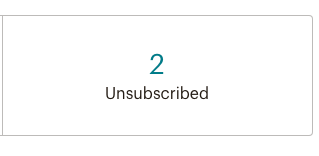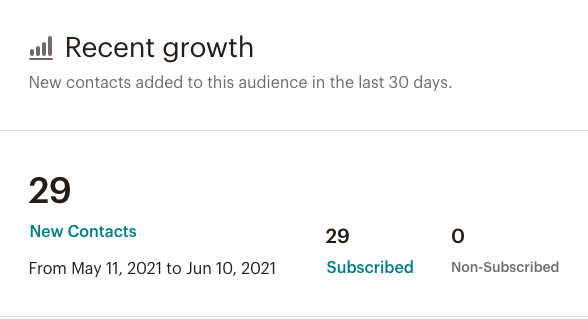Email marketing: 6 key metrics to gauge success.

Email marketing: 6 key metrics to gauge success.
A truly great email marketing campaign can be one of the most effective marketing channels to your business. Email marketing can allow you to boost brand awareness, build credibility, drive revenue, deliver targeted and personalised content to your subscribers. This being said, to reap these benefits, email marketing needs to be done right. Ensuring that emails are well-designed, well written and engaging, concise, and use the best subject lines and descriptions is a great place to start. But how do you know how well your email campaigns are performing and whether you need to make changes?
Cue email marketing metrics!
Email marketing metrics provide data that allows us to measure how well our email campaigns are performing. Metrics can help you to understand if your subscriber list is growing, whether people are engaging with your content, whether your emails are being opened, and if there are any issues with your emails, i.e. if they’re being flagged as spam or delivery has failed.

So which 6 email marketing metrics are the most important to look at to check the success of your campaign?
Metric 1: Click-through rate
The click-through rate metric shows the percentage of email subscribers who clicked on one or more links within your email. It gives you an indication of how people are engaging with your content and on most email tools you can break this down further to see which specific links people were clicking on the most.
Calculate: (Unique clicks ÷ Number of delivered emails) x 100
To see how your email click-through rate is faring, compare it to your industry average. If your emails need a bit of help, you’ll be pleased to know that click-through rates can be elevated in a number of ways. For instance, by making your call-to-action more compelling, keeping your templates creative and interesting and by producing relevant content and sending to an appropriate list segment.

Metric 2: Open rate
The open rate metric tells us the number of emails in a campaign that have been opened by the recipient.
Calculate: The number of unique email opens ÷ number of emails sent – the number of bounces
A high open rate usually means that a lot of people are interested in hearing from you. Bear in mind though that open rate success can look wildly different depending on the purpose of your email and the industry you operate in, so remember to benchmark against your industry’s average open rate to understand your success.

If your open rate is looking a little low, there are things that you can do to improve it. Actions such as removing inactive subscribers from your audience list periodically, segmenting your list to ensure that only relevant messages go to certain subscribers, starting an A/B campaign to see if timing has an effect on the open rate, or maybe adjusting your subject line to make it more enticing.
Metric 3: Unsubscribe rate
This metric tells us how many recipients have opted out of communications, the unsubscribe rate shows us that recipients have lost interest in our emails for whatever reason.
Calculate: Number of unsubscribes ÷ emails delivered x 100
Email marketing tools such as MailChimp and GetResponse can even tell you which users unsubscribe and why (if they have opted to leave a reason). There are many reasons why a subscriber may opt to unsubscribe, for example, the recipient being sent too many emails or even the emails themselves no longer relating to the recipient.

Metric 4: Conversion rate
A really interesting metric to look at is Conversion rate. This metric looks at the percentage of subscribers who clicked a link within an email and then completed an action, for example making a booking, downloading a form, or buying a product.
Calculate: (Number of people who completed the action ÷ Total of successfully delivered emails) x 100
Similarly to the open rate, assessing if your conversion rate is ‘good’ is highly dependent on other factors, such as the industry you operate in and the type of email that you’ve released i.e. newsletter, abandoned cart, order follow-up etc.
To get that conversion rate as high as it can be, consider looking at the following aspects:
- Subject lines: As the first impression of your email, getting the subject line right is incredibly important. 33% of email recipients open them because of a great subject line.
- Segment and personalise: Tailoring your offer to specific buyers means that you are sending targeted content to a person who will probably want to read it and potentially convert!
- Try some incentives: Everyone loves a bargain, so including an offer, voucher, or even just a well placed sales banner within your email could be the key to triggering the interest of your subscribers and getting them converting.
- Check that copy: Your copy needs to be persuasive and demonstrate the value that the reader can get from your offering. People want to know why they should click.

Metric 5: List growth rate
List growth rate tells you how your mailing list is growing and how many new contacts are signing up to receive your emails.
Calculate: (Number of new subscribers − Number of unsubscribes)÷ Total number of email addresses on a list x 100
If your email subscriber list is growing at a good rate then you know your tactics are working, however if your rate is low then you can work on a strategy to increase your sign ups. Actions like adding multiple signup forms to your website, running a giveaway or competition or offering a discount per sign up are all ways in which you can work to increase your subscriber base.

Metric 6: Bounce rate
The bounce rate metric tells us the number of emails which have been blocked and returned to the sender. Bounced emails are identifiable as two types; soft bounce and hard bounce. A soft bounce can be caused by a temporary delivery issue such as the recipient’s inbox being too full or a file being too large to send. Hard bounces are more of a permanent issue and occur due to an issue such as an invalid email address, or due to being blocked by the subscriber.
Calculate: (Total clicks OR unique clicks ÷ Number of delivered emails) x 100
Although bounce rate doesn’t tell you about the success of your campaign from a customer actions perspective, it is so important to know if there are issues with your campaigns delivery. Additionally, by removing hard bounce email addresses from your list, you protect your reputation as internet providers tend to factor hard bounces against you.

Overall, there are a plethora of email marketing metrics that you can use to better understand how well your email campaigns are performing and which areas could be improved. These 6 metrics will give you a good springboard to start from in your journey to the perfect email marketing campaign.




